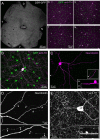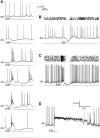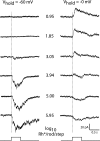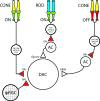Inhibitory inputs tune the light response properties of dopaminergic amacrine cells in mouse retina
- PMID: 23636722
- PMCID: PMC3727066
- DOI: 10.1152/jn.00118.2013
Inhibitory inputs tune the light response properties of dopaminergic amacrine cells in mouse retina
Abstract
Dopamine (DA) is a neuromodulator that in the retina adjusts the circuitry for visual processing in dim and bright light conditions. It is synthesized and released from retinal interneurons called dopaminergic amacrine cells (DACs), whose basic physiology is not yet been fully characterized. To investigate their cellular and input properties as well as light responses, DACs were targeted for whole cell recording in isolated retina using two-photon fluorescence microscopy in a mouse line where the dopamine receptor 2 promoter drives green fluorescent protein (GFP) expression. Differences in membrane properties gave rise to cell-to-cell variation in the pattern of resting spontaneous spike activity ranging from silent to rhythmic to periodic burst discharge. All recorded DACs were light sensitive and generated responses that varied with intensity. The threshold response to light onset was a hyperpolarizing potential change initiated by rod photoreceptors that was blocked by strychnine, indicating a glycinergic amacrine input onto DACs at light onset. With increasing light intensity, the ON response acquired an excitatory component that grew to dominate the response to the strongest stimuli. Responses to bright light (photopic) stimuli also included an inhibitory OFF response mediated by GABAergic amacrine cells driven by the cone OFF pathway. DACs expressed GABA (GABA(A)α1 and GABA(A)α3) and glycine (α2) receptor clusters on soma, axon, and dendrites consistent with the light response being shaped by dual inhibitory inputs that may serve to tune spike discharge for optimal DA release.
Keywords: amacrine cell; dopaminergic neuron; electrophysiology; immunocytochemistry; retina.
Figures











Similar articles
-
Response Properties of a Newly Identified Tristratified Narrow Field Amacrine Cell in the Mouse Retina.PLoS One. 2015 Sep 9;10(9):e0137702. doi: 10.1371/journal.pone.0137702. eCollection 2015. PLoS One. 2015. PMID: 26352594 Free PMC article.
-
Disruption in dopaminergic innervation during photoreceptor degeneration.J Comp Neurol. 2016 Apr 15;524(6):1208-21. doi: 10.1002/cne.23899. Epub 2015 Sep 28. J Comp Neurol. 2016. PMID: 26356010 Free PMC article.
-
Dopamine D1 receptor activation reduces local inner retinal inhibition to light-adapted levels.J Neurophysiol. 2019 Apr 1;121(4):1232-1243. doi: 10.1152/jn.00448.2018. Epub 2019 Feb 6. J Neurophysiol. 2019. PMID: 30726156 Free PMC article.
-
Extrasynaptic release of GABA and dopamine by retinal dopaminergic neurons.Philos Trans R Soc Lond B Biol Sci. 2015 Jul 5;370(1672):20140186. doi: 10.1098/rstb.2014.0186. Philos Trans R Soc Lond B Biol Sci. 2015. PMID: 26009765 Free PMC article. Review.
-
The mysterious middlemen making your vision pop: understanding the function of amacrine cells.J Physiol. 2025 May 5. doi: 10.1113/JP287958. Online ahead of print. J Physiol. 2025. PMID: 40321008 Review.
Cited by
-
Melanopsin photoreception differentially modulates rod-mediated and cone-mediated human temporal vision.iScience. 2022 Jun 3;25(7):104529. doi: 10.1016/j.isci.2022.104529. eCollection 2022 Jul 15. iScience. 2022. PMID: 35754721 Free PMC article.
-
Early Retinal Neuronal Dysfunction in Diabetic Mice: Reduced Light-Evoked Inhibition Increases Rod Pathway Signaling.Invest Ophthalmol Vis Sci. 2016 Mar;57(3):1418-30. doi: 10.1167/iovs.15-17999. Invest Ophthalmol Vis Sci. 2016. PMID: 27028063 Free PMC article.
-
The Retinal Response to Sinusoidal Electrical Stimulation.IEEE Trans Neural Syst Rehabil Eng. 2016 Apr;24(4):413-23. doi: 10.1109/TNSRE.2015.2415811. Epub 2015 Apr 2. IEEE Trans Neural Syst Rehabil Eng. 2016. PMID: 25850091 Free PMC article.
-
Role of dopamine in distal retina.J Comp Physiol A Neuroethol Sens Neural Behav Physiol. 2014 May;200(5):333-58. doi: 10.1007/s00359-014-0906-2. Epub 2014 Apr 12. J Comp Physiol A Neuroethol Sens Neural Behav Physiol. 2014. PMID: 24728309 Review.
-
Marking cells with infrared fluorescent proteins to preserve photoresponsiveness in the retina.Biotechniques. 2014 Nov 1;57(5):245-53. doi: 10.2144/000114228. eCollection 2014 Nov. Biotechniques. 2014. PMID: 25391913 Free PMC article.
References
-
- Alonso A, Llinas RR. Subthreshold Na+-dependent theta-like rhythmicity in stellate cells of entorhinal cortex layer II. Nature 342: 175–177, 1989 - PubMed
-
- Armstrong CM, Gilly WF. Access resistance and space clamp problems associated with whole-cell patch clamping. Methods Enzymol 207: 100–122, 1992 - PubMed
-
- Bloomfield SA, Dacheux RF. Rod vision: pathways and processing in the mammalian retina. Prog Retin Eye Res 20: 351–384, 2001 - PubMed
-
- Bunney BS, Grace AA. Acute and chronic haloperidol treatment: comparison of effects on nigral dopaminergic cell activity. Life Sci 23: 1715–1727, 1978 - PubMed
Publication types
MeSH terms
Grants and funding
LinkOut - more resources
Full Text Sources
Other Literature Sources
Molecular Biology Databases
Miscellaneous

